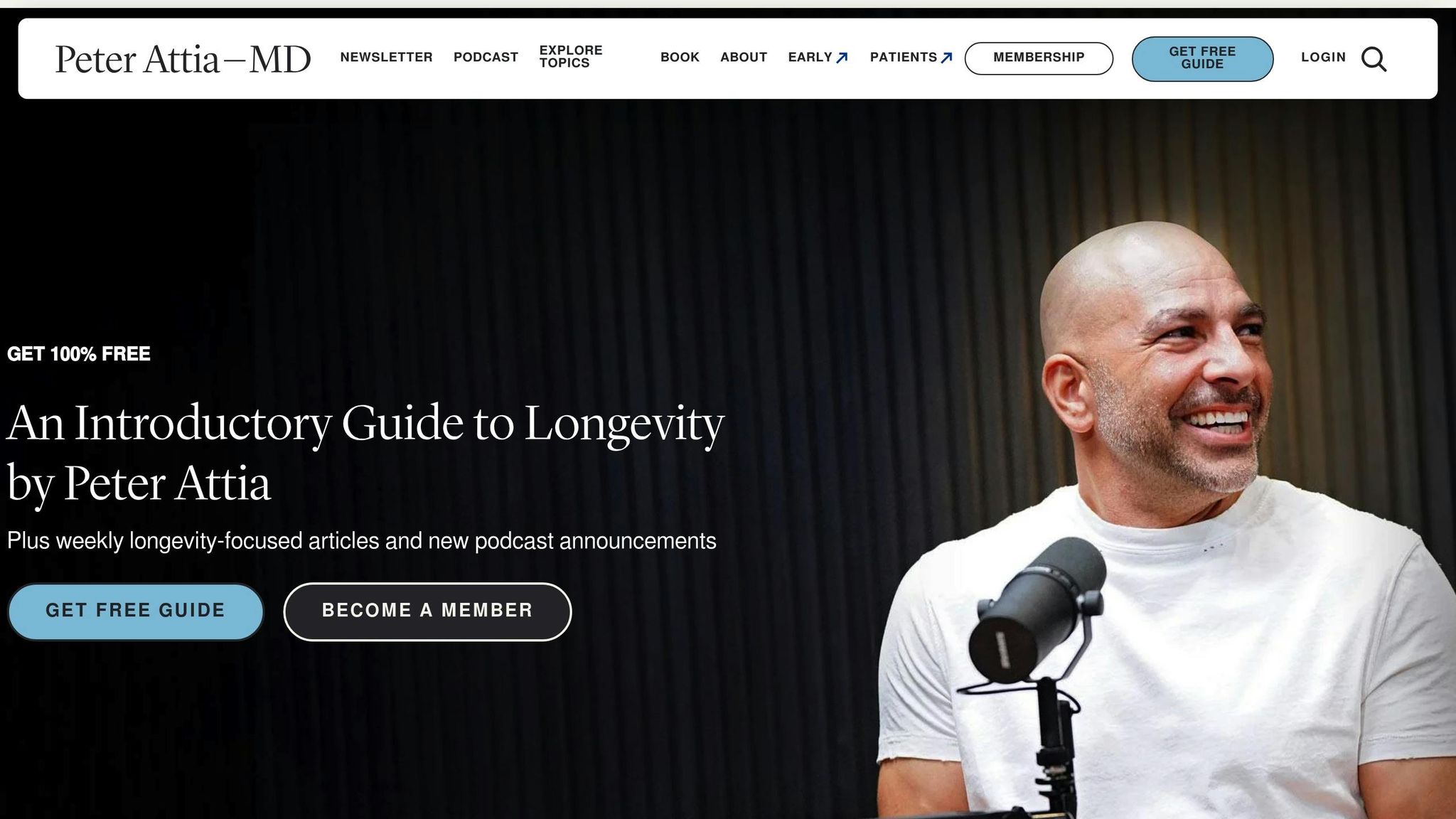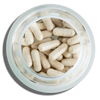Here’s the quick answer:
Both plant and animal proteins have unique benefits for aging. Animal proteins are better for building and maintaining muscle due to their complete amino acid profile and higher digestibility. However, plant proteins are linked to lower risks of heart disease, diabetes, and longer life expectancy. A balanced diet combining both types is ideal for healthy aging.
Key Takeaways:
- Animal Protein: Complete amino acids, higher leucine content, great for muscle health, faster absorption.
- Plant Protein: Lower disease risks, promotes longevity, provides fiber and other nutrients, slower absorption benefits heart health.
Quick Comparison Table:
| Factor | Animal Protein | Plant Protein |
|---|---|---|
| Amino Acid Profile | Complete, high in leucine | Incomplete, but can be combined |
| Digestibility | Higher (90%+) | Lower (45–80%), can improve with processing |
| Muscle Health | Best for muscle building and maintenance | Effective with proper intake and combos |
| Disease Risk | Linked to higher risks (e.g., heart disease) | Reduces risks of chronic diseases |
| Longevity | Supports early-life survival | Boosts later-life survival and healthy aging |
What You Should Do:
- Aim for 1.2–1.6 grams of protein per kg of body weight daily if you’re over 50.
- Combine plant proteins (like beans and grains) to get all essential amino acids.
- Mix lean animal proteins (like fish or eggs) with plant-based options for a balanced diet.
Bottom Line: Both types of protein are important for aging well. Animal protein is great for muscle health, while plant protein supports overall longevity and disease prevention. Balance is key!
Animal protein vs. plant protein: determining quality and bioavailability | Peter Attia

Protein Quality and Amino Acid Profile
The quality of protein plays a critical role in healthy aging, largely determined by its essential amino acid content and how well the body can digest and absorb it.
Complete vs. Incomplete Amino Acids
Our bodies require nine essential amino acids from food sources. Animal proteins - like meat, eggs, and dairy - are labeled "complete" because they naturally contain all nine essential amino acids in the right proportions [3][7]. This makes them particularly effective for older adults who need sufficient protein to combat muscle loss associated with aging.
Most plant-based proteins, on the other hand, are considered incomplete since they often lack one or more essential amino acids [3]. For instance, grains like wheat tend to be low in lysine, while legumes may fall short on methionine. However, this doesn’t mean plant proteins can’t meet your needs. It just requires some thoughtful planning.
By combining different plant protein sources, you can create a complete amino acid profile. For example:
- Pairing grains with legumes, such as rice and beans
- Enjoying pita bread with hummus
Research shows that well-planned plant protein combinations can achieve up to 98% similarity to the amino acid composition of animal proteins [11].
But there’s more to protein than just its amino acid profile. Its impact on aging also depends on how efficiently the body can absorb it.
How Well Your Body Absorbs Each Type
Even the most complete protein loses its value if it isn’t easily absorbed. This is where the differences between animal and plant proteins become particularly important for older adults.
Animal proteins generally have the upper hand in absorption. They are digested and absorbed more effectively than plant proteins [10]. For example, a study comparing equal portions of different protein sources found:
- 2 oz of pork provided 7.36 grams of essential amino acids with high bioavailability
- Eggs delivered 5.38 grams
- In contrast, black beans offered only 3.02 grams, and almonds just 1.85 grams [6].
| Protein Source | Digestibility (%) | Key Notes |
|---|---|---|
| Animal Sources | ||
| Whey | 104 | Fastest absorption |
| Egg | 98 | High biological value |
| Milk | 96 | Well-balanced amino acids |
| Casein | 99 | Slower, sustained release |
| Plant Sources | ||
| Soy protein isolate | 98 | Best plant option |
| Pea protein concentrate | 99 | Processed for better absorption |
| Cooked black beans | 83 | Lower but still valuable |
| Wheat | 91 | Often low in lysine |
Plant proteins face unique absorption challenges. Their structure, fiber content, and natural compounds can make digestion less efficient [8]. However, processing methods can significantly improve this. For example, heat-treated plant proteins show an 18% increase in digestibility compared to their unprocessed counterparts [8].
For older adults, both amino acid completeness and absorption efficiency are crucial to preventing sarcopenia (age-related muscle loss). Muscle protein synthesis in seniors is 30-40% lower after consuming soy or wheat protein compared to whey [8]. One reason is that plant proteins generally contain less leucine (7.1% ± 0.8%) compared to animal proteins (8.8% ± 0.7%) [8]. Leucine is vital for triggering muscle protein synthesis.
However, studies show that consuming 30 grams or more of plant protein per meal can help older adults maintain or even build muscle mass during resistance training [8]. While plant proteins may be less efficient gram-for-gram, eating adequate amounts can still support healthy aging.
Interestingly, the slower absorption of plant proteins isn’t always a drawback. The gradual release of nutrients can benefit heart health and help regulate blood sugar levels [9]. This makes plant proteins a valuable addition to a diet focused on longevity and overall well-being.
Muscle Health and Age-Related Muscle Loss
Starting at age 30, muscle mass begins to decline at a rate of 0.3–0.8% per year, with this loss speeding up after the age of 50–60. During this time, lower limb strength can drop by 2–4% annually [15]. Among older adults, sarcopenia - a condition characterized by significant muscle loss - affects about one-third of the aging population living in the community. This condition doesn't just impact physical health; it can also double hospitalization costs compared to those without it [12][15]. Choosing the right protein source plays a key role in reducing these losses.
Fortunately, combining protein intake with resistance training has proven to be one of the most effective ways to combat muscle loss associated with aging [12]. The type of protein consumed also plays a crucial role in how muscles respond.
Animal Protein and Muscle Building
Animal proteins are considered the benchmark for supporting muscle health in older adults. They are rich in leucine, an amino acid that triggers mTORC1, a key pathway for muscle protein synthesis [16]. Whey protein, for example, is absorbed quickly, providing a rapid boost to muscle-building processes, while casein is digested more slowly, offering sustained muscle support over time [16].
Plant Protein Options and Combinations
Though animal proteins are highly effective, plant-based protein options are gaining recognition as viable alternatives. Research shows that plant proteins, when consumed in adequate amounts and combined to balance essential amino acids, can help maintain muscle mass. Enhanced plant protein blends fortified with leucine, arginine, and cysteine have shown muscle-preserving benefits comparable to whey protein, as demonstrated in studies involving hybrid dairy-plant interventions in aged mice [13][14].
The best protein strategy often depends on individual muscle health. For healthy older adults, plant proteins can be particularly effective in preventing sarcopenia by reducing inflammation. On the other hand, individuals already experiencing muscle loss may benefit more from a diet with a higher proportion of animal protein [17].
Plant proteins also address challenges like reduced appetite or dental issues, which can make eating difficult for some older adults [15]. Incorporating plant protein into up to 50% of the total dietary protein intake can still meet the body's needs for protein and essential amino acids [17].
Health Outcomes and Lifespan Effects
The type of protein you consume plays a significant role in shaping your long-term health and how you age. Research spanning decades has highlighted clear differences between plant-based and animal-based proteins when it comes to reducing chronic disease risks and promoting a longer, healthier life.
Disease Risk Differences
Protein isn’t just about building muscle - it also has a major impact on your risk for chronic diseases, which are critical to healthy aging.
Heart disease and diabetes are two areas where protein choices make a noticeable difference. Diets with a higher ratio of plant protein to animal protein are linked to a 19% lower risk of cardiovascular disease and a 27% lower risk of coronary heart disease compared to diets dominated by animal proteins [19]. For diabetes, the numbers are even more striking: a 5% increase in protein from meat is associated with a 34% higher risk of developing diabetes [20].
Plant proteins, particularly soy protein containing isoflavones, offer additional heart health benefits. Studies show that soy protein can significantly reduce total and LDL cholesterol levels compared to animal proteins [18]. Isoflavones in soy help enhance the body’s ability to clear cholesterol from the bloodstream, making it a powerful tool for reducing heart disease risk.
"The study findings were entirely consistent with many previous studies which found that eating more plant-based protein instead of red meat reduces the risk of many cardiometabolic conditions including heart disease, stroke, hypertension, high cholesterol, diabetes, and obesity."
- Cheng-Han Chen, MD, Interventional Cardiologist and Medical Director of the Structural Heart Program at MemorialCare Saddleback Medical Center [19]
Plant proteins also have a unique amino acid profile that helps lower blood pressure, further supporting their cardiovascular benefits [18]. This explains why diets rich in plant-based foods consistently lead to better heart health outcomes.
For older adults, the choice of protein becomes even more critical. Research shows that higher consumption of animal protein is linked to greater diabetes prevalence among older populations [20]. In contrast, consuming more than 31 grams of plant protein daily can enhance physical performance and reduce the risk of frailty in older individuals [21].
These differences in disease risk aren’t just abstract - they directly influence how long and how well people live.
Lifespan and Healthy Aging
Lower disease risk often translates into longer, healthier lives. Studies reveal fascinating patterns in how protein types affect longevity at different stages of life. A global analysis of 101 countries spanning from 1961 to 2018 found that animal proteins improve early-life survival, while plant proteins boost survival rates later in life when paired with lower fat intake [2].
"Our study suggests a mixed picture when it comes to comparing the health impacts of meat- versus plant-based protein at a population level. For the under-fives, a food system that supplies large amounts of animal-based proteins and fats – such as meat, eggs, and dairy – lowered rates of infant mortality. However, for adults, the reverse was true, where plant-based proteins increased overall life expectancy."
- Caitlin J. Andrews [5]
Plant proteins also seem to impact biological aging at the cellular level. Replacing 5% of animal protein with plant protein reduces the odds of accelerated aging by 19–28% and improves the likelihood of maintaining longer telomeres - markers of cellular health - by 12% [4]. This suggests that plant proteins may help slow the aging process.
The mortality benefits of plant proteins are especially pronounced in middle-aged adults. Among those aged 50–65, higher protein intake is linked to increased risks of all-cause and cancer-related deaths [22]. However, in older adults, adequate protein intake - especially from plants - becomes essential for preventing frailty and maintaining physical function.
When it comes to healthy aging, plant proteins consistently show an advantage. Swapping animal or dairy proteins for plant proteins is associated with a 38% and 26% higher likelihood of healthy aging, respectively [25]. Even small adjustments, like replacing 3% of calories from various sources with plant protein, can improve the odds of healthy aging by 22–58% [25].
Striking the right balance is key. Harvard researchers recommend that most Americans aim for at least a 1:2 plant-to-animal protein ratio, compared to the current average of 1:3 [24]. For heart health, a ratio of 1:1.3 or higher in favor of plant proteins provides the greatest benefit.
"Most of us need to begin shifting our diets toward plant-based proteins. We can do so by cutting down on meat, especially red and processed meats, and eating more legumes and nuts. Such a dietary pattern is beneficial not just for human health but also the health of our planet."
- Frank Hu, Fredrick J. Stare Professor of Nutrition and Epidemiology at Harvard Chan School [24]
A balanced diet that prioritizes plant proteins while occasionally incorporating lean animal proteins appears to deliver the best results [23]. This means reducing reliance on red and processed meats and focusing more on protein-packed vegetables, grains like quinoa, and legumes for optimal health.
sbb-itb-4f17e23
Practical Tips for Older Adults
As we age, maintaining proper protein intake becomes increasingly important. Nearly 50% of adults over 80 experience sarcopenia, a condition where muscle mass and strength decrease, and 46% of people aged 51 and older fall short of their daily protein recommendations [1]. A thoughtful approach to protein consumption can help preserve strength and independence.
Experts recommend that adults over 50 aim for 1.2 to 1.6 grams of protein per kilogram of body weight daily, which is higher than the amount needed by younger adults [27]. For instance, a 150-pound person (around 68 kilograms) would require approximately 82–109 grams of protein each day.
Getting the Most Nutrition from Your Meals
Understand your protein needs by using a USDA calculator or consulting your healthcare provider. Spread your protein intake evenly across breakfast, lunch, and dinner. Your muscles can only process a certain amount of protein at a time, so distributing it throughout the day supports better muscle protein synthesis [3, 46].
Mix animal and plant proteins for a balanced diet. While animal proteins provide all essential amino acids, plant proteins contribute fiber and other nutrients. As registered dietitian Taylor Wolfram, R.D.N. notes, "plants also deliver nutrients such as fiber and phytonutrients that you won't get from animal proteins" [26]. Pairing grains with beans, for example, can ensure a complete amino acid profile [15].
For those who might have difficulty chewing, opt for softer, protein-rich foods like tofu, Greek yogurt, cottage cheese, eggs, or well-cooked beans and lentils [28].
If meeting your protein requirements through food alone feels challenging, consider protein supplements. Whey protein is particularly effective for muscle building in older adults, while plant-based protein powders can also be a helpful addition [1].
Make small upgrades to your meals rather than overhauling your diet. For instance, stir nut butter into oatmeal, blend protein powder into smoothies, or toss beans into soups. These simple tweaks can significantly boost your protein intake and support healthy aging [28].
Plant Protein Meal Planning
Effective meal planning can make it easier to meet your daily protein goals, especially when focusing on plant-based options.
- Plan meals for a few days at a time to simplify meal prep [29]. This ensures you always have protein-packed dishes ready to go.
- Stock up on versatile pantry staples like dried or canned beans, lentils, quinoa, nuts, seeds, and nut butters. These ingredients are easy to incorporate into various meals [29].
- Keep frozen fruits and vegetables on hand for convenience and nutrition. Frozen produce often retains more nutrients than fresh produce that has traveled long distances. Frozen edamame, for example, is a quick addition to salads or stir-fries [29].
- Try overnight recipes for grab-and-go meals. Overnight oats made with chia seeds, nuts, and protein powder create a high-protein breakfast that’s ready when you wake up [29].
- Make simple swaps in familiar dishes. Replace ground beef with lentils in pasta sauce, use tofu in a breakfast scramble, or stir white beans into chicken soup for added protein [28].
- Fill half your plate with plant-based options at each meal. Include protein-rich choices like beans, quinoa, nuts, and seeds alongside your usual proteins [28].
- Choose foods that reheat well to keep meal prep fresh and easy. Beans, lentils, quinoa, and many cooked vegetables, such as root vegetables, broccoli, and bell peppers, maintain their texture when reheated [29].
Incorporating these strategies into your routine can simplify your approach to protein intake while supporting muscle health and overall well-being as you age.
Side-by-Side Comparison
Building on the amino acid and digestibility details above, this side-by-side breakdown highlights the differences between plant and animal proteins, showing how each type uniquely contributes to healthy aging.
| Factor | Animal Protein | Plant Protein |
|---|---|---|
| Amino Acid Profile | Complete proteins with all 9 essential amino acids. Higher leucine content (8.5–13.6% in dairy proteins) supports muscle growth. Whey contains 52% essential amino acids, while beef has 44% [30]. | Most are incomplete, missing one or more essential amino acids, and typically lower in leucine (6–8%). Soy is an exception, offering a complete profile and 38% essential amino acids [30]. |
| Digestibility | Highly digestible, with rates exceeding 90% for dairy, eggs, and meat. Cooked beef, chicken, pork, and fish achieve 92–95% digestibility [10][30]. | Lower digestibility, ranging from 45–80% for options like corn, oats, beans, peas, and potatoes. Processing and cooking can enhance absorption [30]. |
| Muscle Health Impact | More effective for muscle building and maintenance, particularly in adults under 60. Animal proteins outperform non-soy plant proteins for muscle preservation [31]. | May lead to smaller muscle mass gains compared to animal protein, especially in younger adults. However, the difference is minimal in adults over 60 [31]. |
| Chronic Disease Risk | Processed meats are linked to an 18% higher risk of heart disease, while unprocessed red meat carries a 9% increased risk [3]. | Plant-based diets are tied to lower blood pressure, reduced cholesterol, and a decreased risk of stroke, cancer, and heart disease-related death [3]. |
| Longevity Outcomes | Supports early life survival and childhood development but may offer fewer benefits for longevity in later life stages [2]. | Associated with a 5% lower risk of death from all causes for every 3% increase in daily energy from plant proteins. Linked to improved survival in later life [32][2]. |
| Practical Considerations | Convenient, ready-to-use complete proteins that simplify meeting daily protein needs. | Requires combining different sources to ensure a complete amino acid profile. Often provides more fiber, which supports digestion. |
This comparison underscores the key differences that can guide your protein choices for aging well. Animal proteins are excellent for muscle building and offer complete nutrition in a single source, making them especially beneficial for younger adults. On the other hand, plant proteins stand out for their role in promoting longevity and reducing risks of chronic diseases. For older adults, the muscle-building edge of animal protein becomes less critical, making the advantages of plant proteins more appealing [31].
Interestingly, soy protein comes close to matching animal proteins in digestibility [30]. Studies also show no meaningful difference between soy and milk proteins when it comes to muscle mass outcomes [31].
Conclusion
When it comes to healthy aging, both plant and animal proteins play unique roles. Animal proteins, known for their complete amino acid profiles, are particularly effective for muscle building and maintenance, especially in younger adults. Meanwhile, plant proteins shine in promoting overall longevity and may help reduce the risk of chronic diseases.
Striking a balance between these two sources seems to offer the most benefits. Research indicates that swapping just 5% of animal protein with plant protein could lower the odds of adverse biological aging markers by 19–28% [33].
The key takeaway? Aim for a mix of lean animal proteins like fish and poultry alongside nutrient-packed plant foods such as beans, lentils, nuts, and whole grains. This combination supports both muscle health and long-term wellness.
Of course, healthy aging isn’t just about protein. A well-rounded approach is crucial. For those looking to enhance their longevity efforts, MASI Longevity Science provides supplements backed by rigorous research. Featuring ingredients like NMN, Resveratrol, Fisetin, and Spermidine, these supplements are designed to address the core drivers of aging. Trusted by over 352,000 members worldwide, they’re a valuable addition to any longevity-focused lifestyle.
FAQs
How can older adults get all essential amino acids from plant-based proteins?
To maintain a well-rounded amino acid profile, older adults can mix and match different plant-based protein sources like beans, lentils, tofu, tempeh, grains, seeds, and plant-based meat alternatives. These foods work together to supply all nine essential amino acids required for muscle maintenance and overall health.
By incorporating a variety of these proteins throughout the day, you can support muscle strength, metabolism, and healthy aging without depending on animal-based options. A diet rich in nutrient-packed plants is crucial for balanced nutrition as you grow older.
What are the benefits of including both plant and animal proteins in your diet as you age?
Including both plant-based and animal proteins in your diet as you get older can offer a mix of benefits that work together to support your health. Plant proteins bring fiber, antioxidants, and essential nutrients to the table, while animal proteins provide high-quality amino acids that are vital for maintaining muscle mass and strength.
By combining these protein sources, you can help maintain muscle health, support a healthier metabolism, and improve your overall nutritional balance - important factors for staying strong and active as you age. This approach ensures your body gets a variety of nutrients needed to thrive in later years.
How does plant protein digestibility compare to animal protein, and how can it be enhanced?
Plant proteins tend to be less digestible than animal proteins. On average, plant-based proteins have a digestibility rate of about 75–80%, while animal proteins range between 90–95%. This difference comes down to the complex structures and natural compounds found in plants, which can make it harder for our bodies to absorb their nutrients.
However, there are ways to improve how well your body can digest plant proteins. Techniques like fermentation or enzyme treatments can break down these tough plant structures, increasing the availability of amino acids. This makes it easier for your body to absorb and use the nutrients. Supporting nutrient absorption is especially important for maintaining muscle health, a strong metabolism, and overall cellular function as you age. These goals align with MASI Longevity Science's mission to advance healthy aging through evidence-based approaches.




